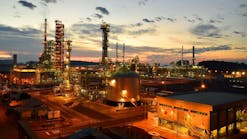Stricter environmental regulations are likely to rule out high sulfur heavy fuel oil in western Europe's inland markets by 2000.
The outlook for bunker fuels is less certain, but the maximum sulfur content could be reduced to 1.5-2%, also by 2000, says a multi-client report by Chem Systems Ltd., London.
The likelihood that environmental rules will become tougher during the rest of the decade presents a dilemma for refiners facing an import crude slate with an increase in average sulfur content.
Chem Systems said the resulting surplus of high sulfur refinery residue streams will force western European processors into major outlays. The total bill could be about $10 billion.
In a separate move, the Dutch Ministry of Environment commissioned a study into an integrated European approach to sharply reduce sulfur dioxide emissions from all products. Arthur D. Little (ADL) will conduct the study, supported by the European Commission and four EC member states.
HIGH SULFUR RESIDUE
Chem Systems said in the present western European refining configuration the unblendable high sulfur residue stream could amount to as much as 15 million metric tons/year by 2000.
There is no obvious choice of residue upgrading process, whether desulfurization or conversion. The most attractive option will depend largely on circumstances of refineries such as crude supply, product markets, and present refinery hardware.
A new option also is available: using residues as feedstock for an integrated gasification process linked directly with combined cycle power generation. Chem Systems said the technology is available and could be attractive in specific circumstances.
This technology can compete with conventional power generation but cannot compete with natural gas at current prices in new combined cycle power generating plants.
Chem Systems warns that high sulfur residue upgrading outlays are expected to show only modest returns. Decisions on spending will be made mainly for strategic and defensive reasons.
Refiners will choose between the desulfurization and conversion options on the basis of perceived economics.
Chem Systems emphasizes that the need for more processing of heavy residue by 2000 stems from shifts in product quality, not from shifts in relative product demands.
Investment decisions will be made against a background of widening price spreads between high and low sulfur fuel oil and sweet and sour crudes as supply/demand pressures develop. The main factors in this area are a decline in North Sea production starting in 1995, a decline in Soviet oil production, and increasing European imports from the Middle East.
PRESENT, FUTURE
Only five European countries--Denmark, Norway, Sweden, Luxembourg, and Netherlands--currently require the use of low sulfur fuel at 1% or less. By 1995 Austria, Finland, Germany, and Switzerland will impose similar limits.
EC rules govern the use of low sulfur fuel oil or flue gas desulfurization in new large combustion plants. There also is a requirement for phased reduction in total sulfur dioxide emissions on a national basis of as much as 70% from the 1980 level.
EC is studying a proposal from France to reduce the sulfur content of all inland sales in all EC members to 2% by 1995 and 1% by 2000.
The marine environment pollution committee of the International Maritime Organization is considering a 50% reduction in sulfur emissions from shipping by 2000. This would reduce sulfur in bunkers to about 1.5%.
Chem Systems said it is very hard to predict the rate at which rules on sulfur emissions will become tougher. The most likely estimate is that 80-95% of the inland heavy fuel oil market will be low sulfur by 2000 or shortly afterward.
One surprising result in comparisons of the range of hydrotreating and hydrocracking processes is that it may be almost as attractive to blend heavy low sulfur streams to fuel oil to upgrade them further.
This suggests that an incremental approach to refinery investment--residue desulfurization followed by conversion--might be preferable to a higher initial investment in a high conversion configuration.
NETHERLANDS STUDY
The move by the Dutch Ministry of Environment to order a study of sulfur dioxide emissions follows a French proposal for limits on sulfur in all oil products presented to the EC council of environmental ministers last summer.
ADL said the study will consider technological, environmental, and economic issues related to major sulfur reductions. Particular emphasis will be given to required changes in refinery process capacity, configuration, and corresponding spending.
It will analyze the consequences for the European refining industry and for oil product prices, together with the international competitive position of the industry.
The project will end in June 1992 with an international symposium. A directive on sulfur limits, expected from the EC early in 1993, is expected to make considerable use of the study results.
As well as the Netherlands Ministry of Environment, the Netherlands Economic Affairs, Transport, and Public Works ministries are participating in the study. So are the French ministries of Environment and Industry, German Ministry of Economic Affairs, Italian Ministry of Industry, and Spanish Ministry of Industry and Energy.
The project will be directed by a steering committee representing all the ministries and the EC. Concawe, the oil industry's European organization for environment and health protection will participate as an observer.
Copyright 1991 Oil & Gas Journal. All Rights Reserved.

